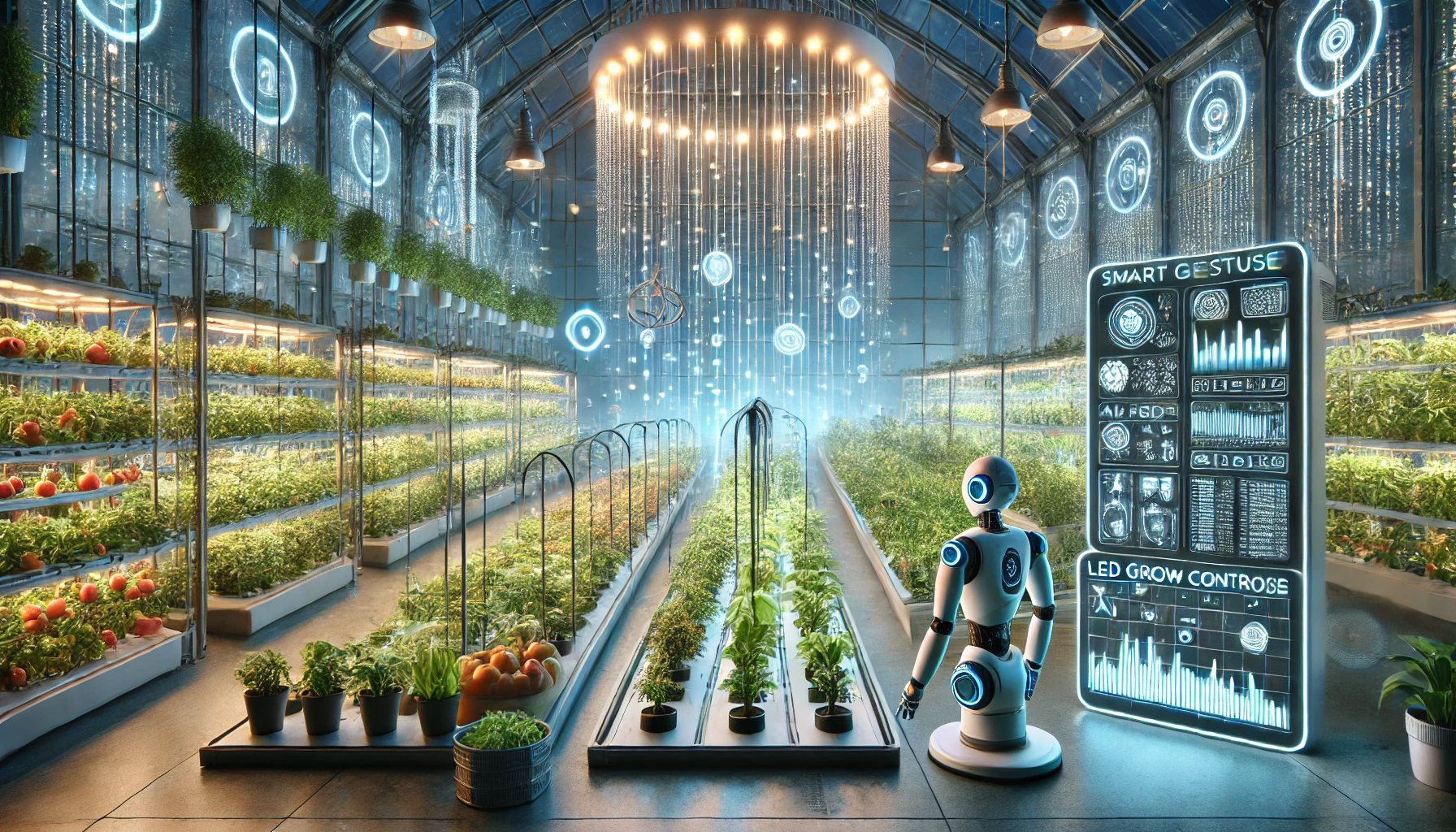Greenhouses have long been used to extend growing seasons, protect crops from harsh weather, and maximize food production. However, traditional greenhouse farming can be resource-intensive, requiring constant monitoring of temperature, humidity, light levels, and irrigation. With the rise of smart technology and automation, modern greenhouses are becoming more efficient, sustainable, and productive than ever before.
Smart greenhouses use automated climate control, IoT sensors, AI-driven monitoring, and robotics to optimize crop growth, reduce resource waste, and enhance food security. These innovations are helping farmers increase yields, conserve water, and minimize environmental impact, making indoor farming a key solution for the future of agriculture.
In this article, we will explore how smart greenhouses are transforming food production, the best technological advancements in indoor farming, and how these innovations are shaping the future of sustainable agriculture.
1. The Challenges of Traditional Greenhouse Farming
1.1. High Energy and Resource Consumption
- Maintaining temperature, lighting, and humidity levels requires significant energy use, increasing costs.
- Smart greenhouses use automated climate control and energy-efficient LED lighting to reduce waste.
1.2. Inefficient Water Use
- Overwatering or poor irrigation management leads to waste and soil degradation.
- AI-powered irrigation systems precisely control water distribution, minimizing loss.
1.3. Manual Labor and Monitoring
- Traditional greenhouses require constant human supervision to adjust ventilation, lighting, and nutrient levels.
- Automation and smart sensors track plant health and environmental conditions in real time.
1.4. Disease and Pest Management
- Pests and fungal diseases can spread quickly in controlled environments.
- AI-driven monitoring systems detect early signs of disease and apply targeted treatments.
1.5. Climate Change and Unpredictable Weather
- Extreme temperatures and water shortages impact outdoor farming, increasing reliance on indoor agriculture.
- Smart greenhouses adapt automatically to climate conditions, ensuring consistent yields.
2. How Smart Technology is Revolutionizing Greenhouses
2.1. AI-Powered Climate Control Systems
- Smart greenhouses use AI-driven climate control to adjust temperature, humidity, and CO₂ levels for optimal plant growth.
- Automated ventilation and shading systems respond to real-time weather changes.
Examples of AI-driven climate control:
- Growlink Smart Greenhouse – Uses AI to optimize temperature, humidity, and irrigation schedules.
- Priva Climate Control – AI-powered greenhouse automation for large-scale farming.
- iUNU LUNA Greenhouse AI – Uses machine learning to predict and adjust plant growth conditions.
2.2. Smart Irrigation and Hydroponic Systems
- IoT-based irrigation sensors track soil moisture and plant hydration needs, reducing water waste.
- Hydroponic and aeroponic systems grow plants without soil, using nutrient-rich water solutions.
Examples of smart irrigation systems:
- Netafim Precision Irrigation – AI-driven drip irrigation for efficient water use.
- AeroFarms Indoor Hydroponics – Uses sensor-controlled aeroponic misting to nourish plants.
- LettUs Grow Aeroponic Greenhouse – Smart farming system that eliminates soil for faster growth.
2.3. AI and Robotics for Crop Monitoring and Harvesting
- Smart greenhouses use AI-powered cameras and sensors to analyze plant growth, detect diseases, and track nutrient levels.
- Robotic systems can automatically prune, pollinate, and harvest crops, reducing labor costs.
Examples of AI-driven crop monitoring:
- Iron Ox Autonomous Greenhouse – AI-driven robotic farming for indoor crop production.
- Octinion Strawberry Picking Robot – Uses AI to identify and harvest ripe fruits without damage.
- Blue River LettuceBot – AI-powered lettuce thinning robot that improves crop spacing.
2.4. Smart LED Lighting for Energy Efficiency
- AI-powered LED grow lights adjust light spectrum and intensity based on plant needs, improving photosynthesis.
- Automated lighting schedules reduce energy consumption and enhance plant growth cycles.
Examples of smart greenhouse lighting:
- Philips Horticulture LED Solutions – AI-controlled full-spectrum LED lighting.
- Heliospectra Smart Grow Lights – Customizable light recipes for different crop stages.
- Fluence Bioengineering LED Systems – AI-powered energy-efficient greenhouse lighting.
2.5. AI-Powered Pest and Disease Detection
- Smart greenhouses use AI cameras and predictive analytics to detect pests, nutrient deficiencies, and infections before they spread.
- Automated biocontrol systems release natural predators or organic treatments as needed.
Examples of AI-driven pest control:
- CropX AI Disease Detection – Predicts fungal outbreaks and pest risks.
- Taranis Precision Pest Management – AI-powered drone monitoring for early detection of infestations.
- EcoRobotix Smart Weeding Robot – Identifies and removes unwanted weeds with pinpoint accuracy.
3. The Benefits of Smart Greenhouses in Agriculture
3.1. Increased Crop Yields
- AI optimizes growing conditions for faster plant development, leading to higher food production.
3.2. Lower Energy and Water Consumption
- Smart climate control reduces heating and cooling costs, while precision irrigation prevents water waste.
3.3. Reduced Labor Costs
- Automation minimizes manual monitoring, pruning, and harvesting, increasing efficiency.
3.4. Year-Round Food Production
- Smart greenhouses enable continuous crop cycles, ensuring food availability in urban and extreme climates.
3.5. Improved Food Safety and Quality
- AI-powered monitoring ensures better disease control, pesticide-free farming, and optimized nutrient levels.
4. The Future of Smart Greenhouses and Indoor Farming
4.1. Fully Autonomous AI Greenhouses
- Future greenhouses will operate without human intervention, using robotic caregivers, AI climate control, and predictive maintenance.
4.2. AI-Enhanced Vertical Farming
- Combining smart greenhouses with vertical farming will maximize space efficiency in urban areas.
4.3. Blockchain and AI for Food Transparency
- AI-driven data tracking will ensure full traceability from seed to consumer, improving food safety and sustainability.
4.4. Net-Zero Energy Greenhouses
- Future greenhouses will integrate solar panels, rainwater harvesting, and AI-driven resource optimization to become completely self-sustaining.
Conclusion: Smart Greenhouses are the Future of Agriculture
Smart greenhouses are revolutionizing food production, making indoor farming more efficient, sustainable, and technologically advanced. Whether through AI-driven climate control, precision irrigation, robotic automation, or smart LED lighting, technology is ensuring higher yields, lower costs, and reduced environmental impact.
As AI continues to evolve, smart greenhouses will become fully autonomous, self-sustaining, and capable of feeding cities efficiently, securing the future of indoor agriculture. Now is the time to embrace smart greenhouse technology for a more sustainable and food-secure world! 🚀🌿✨

